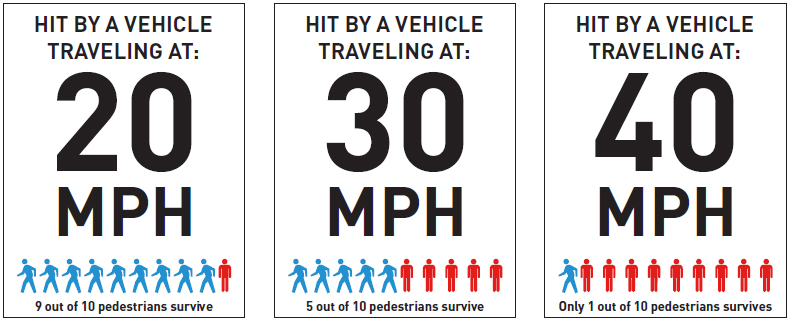This week the City of Chicago released more information about its upcoming Vision Zero Action Plan.
Chicago Department of Transportation Commissioner Rebekah Scheinfeld made the case for Vision Zero in a speech at City Club on Monday.
In her comments, she said every traffic death is unacceptable and that we have the tools to stop these senseless tragedies. In addition to the dozen or so city agencies that will be involved in Chicago’s Vision Zero effort, she called upon everyone who uses city streets to start thinking about supporting Vision Zero.
One key part of the plan is reducing driving speed and encouraging people driving to follow the legal speed limits.
The Vision Zero plan identifies driver speed as the most important factor in determining crash risk and crash severity.
The city can manage speed by redesigning streets to calm traffic and enforcing appropriate speed limits. In our Vision Zero policy recommendations to the city, we urged the city to consider reducing the default speed limit on all neighborhood streets, and pedestrian, bicycle and transit priority areas.
See more of our policy recommendations on our Vision Zero campaign page.
Effectively managing speeds also relies on redesigning high crash corridors and adding new infrastructure. To make progress on Vision Zero over the next three years, the city needs to aggressively plan, design and implement more projects on these corridors – which will require more funding.
That’s why we’re calling for the city to establish a Vision Zero fund in the FY2018 budget. The fund could provide additional resources for capital projects on high crash corridors, in addition to Vision Zero education and enforcement activities.
Commissioner Scheinfeld also said the plan includes a goal to pass an ordinance requiring trucks to install side guards and safety mirrors to prevent serious injury or death resulting from collisions with people biking and walking. The regulation would apply to the city’s own fleet in addition to city contractors, while encouraging compliance from private companies.
Commercial vehicle regulation became a priority in the advocacy community after several tragic crash fatalities in recent years.
We worked with crash victim Dee Palagi, who was who was struck by a semi-truck while bicycling in West Town and had to have her leg amputated. Dee says new regulations could help prevent serious injury and save lives in crashes like hers.
See more stories from crash victims on our Vision Zero campaign page.
Vision Zero has been one of our top priorities over the last several years. In 2015 we were joined by physicians, traffic safety experts and victims of traffic crashes in calling on the city to develop a Vision Zero Action Plan that brings all city agencies to the table. Last year the city established a task force and began work on a plan, which is expected to be released this spring.
Graphic Credit: City of Seattle

